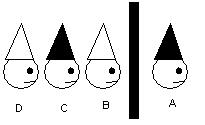5 problems
These problems were selected from the book "In Polya's Footsteps, Miscellaneous problems and Essays" by Ross Honsberger. Each problem requires different problem solving skills. It will be good to note down what was the thinking process behind each solution.
1) 4 consecutive even numbers are removed from the set A={1,2,...n} If the average of the remaining numbers is 51.5625, which 4 numbers are removed?
2) Suppose u and v are real numbers such that
u+u^2+...+u^8+10u+^9=v+v^2+...+v^(10)+10v^(11)=8
Which is bigger? u or v?
3) Suppose a quadilateral ABCD has a circumcircle with centre O and incircle with centre I. Let E be the intersection of the diagonals AC and BD. Show that O, I and E are collinear.
4) Consider an acute triangle ABC. Suppose the median, angle bisector and altitude from A to BC cuts the angle BAC into 4 equal angles. What is the angle BAC?
5) Show that for any positive integer, there exists n consecutive integers such that none of which is an integral power of a prime.



